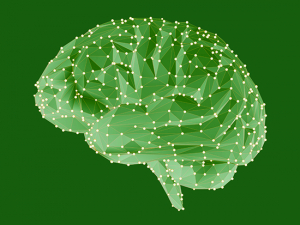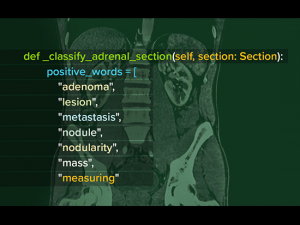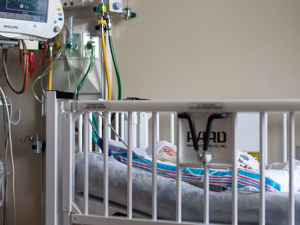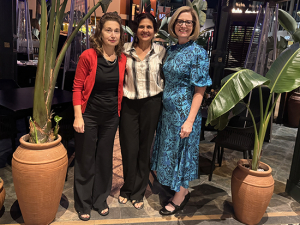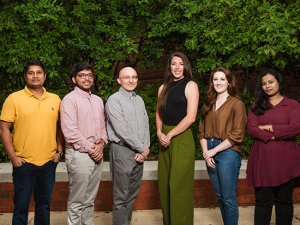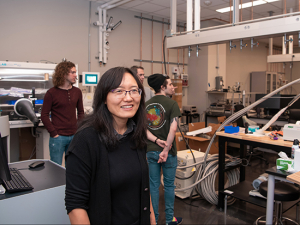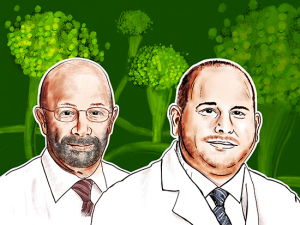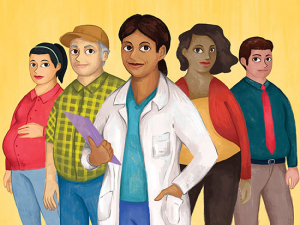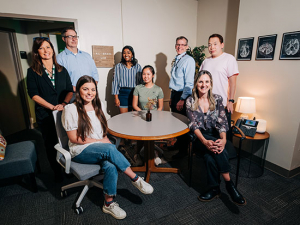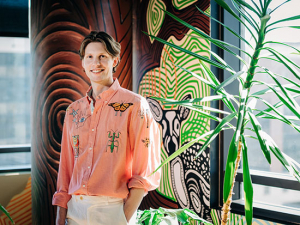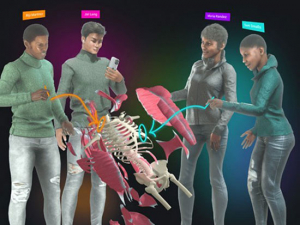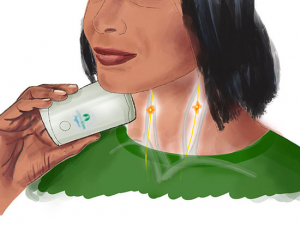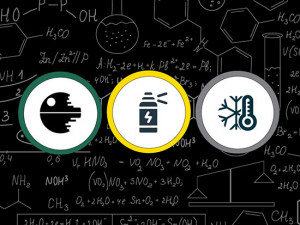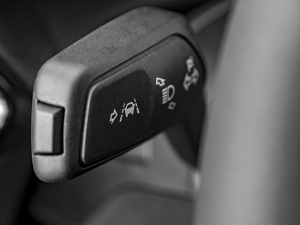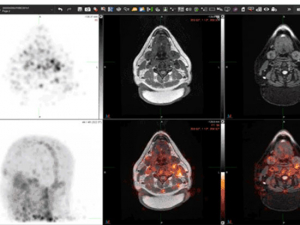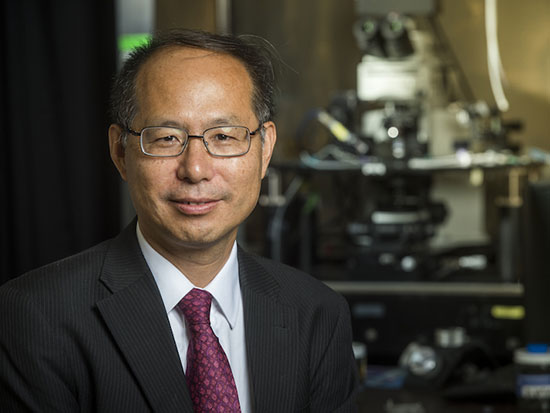 Professor Jianguo Gu, Ph.D., was the first to publish direct evidence that the Piezo2 channel is the sensor for light touch in 2014. His lab continues to pioneer research that could ease the burden of chemotherapy, excruciating facial pain and other conditions.He did not really have a spot for a graduate student. When a doctoral candidate came by his office at the University of Florida and asked to join his research on the cellular and molecular mechanisms underlying neuropathic pain, Jianguo Gu, Ph.D., was inclined to say no. But when he heard the student’s motivation, he changed his mind. “She told me she had pain that could be induced by gentle touch and wanted to study it,” Gu recalled. “When her leg brushed against her pants, it would hurt. That is what is known as mechanical allodynia, or touching-induced pain. One of the most important purposes of research is to help people understand clinical problems. That is our commitment and duty. So I said, ‘Come on, and we will look into it.’”
Professor Jianguo Gu, Ph.D., was the first to publish direct evidence that the Piezo2 channel is the sensor for light touch in 2014. His lab continues to pioneer research that could ease the burden of chemotherapy, excruciating facial pain and other conditions.He did not really have a spot for a graduate student. When a doctoral candidate came by his office at the University of Florida and asked to join his research on the cellular and molecular mechanisms underlying neuropathic pain, Jianguo Gu, Ph.D., was inclined to say no. But when he heard the student’s motivation, he changed his mind. “She told me she had pain that could be induced by gentle touch and wanted to study it,” Gu recalled. “When her leg brushed against her pants, it would hurt. That is what is known as mechanical allodynia, or touching-induced pain. One of the most important purposes of research is to help people understand clinical problems. That is our commitment and duty. So I said, ‘Come on, and we will look into it.’”
The molecular basis of touch was not very well known at the time, says Gu, who today is Edward A. Ernst, M.D., Endowed Chair and director for Pain Research in the Department of Anesthesiology and Perioperative Medicine in the UAB Marnix E. Heersink School of Medicine. “We looked at the literature and pinpointed these cells, Merkel cells, which form a complex at nerve terminals called Merkel discs,” Gu said. “They are very important for gentle touch and the ability to differentiate shapes. Blind people rely on Merkel discs to read Braille. There had been work on these cells in the 1950s and 1960s, but then the field had moved on in other directions. So we started from scratch.”
A Nobel Prize for temperature and touch
On Oct. 4, 2021, the Nobel Prize in Physiology or Medicine 2021 was awarded to physiologist David Julius, Ph.D., and neuroscientist Ardem Patapoutian, Ph.D., for their discoveries of receptors for temperature and touch, respectively. The Nobel committee cited the importance of Patapoutian’s work on the Piezo2 ion channel, which is expressed at high levels in sensory cells in the fingertips and elsewhere. Physical force, such as a hug or a hand brushing across a cheek, triggers the Piezo2 channels to open, turning mechanical stimuli into electrical signals and nerve impulses.
“One of the most important purposes of research is to help people understand clinical problems. That is our commitment and duty. So I said, ‘Come on, and we will look into it.’”
In its detailed recap of the science behind the prize, the Nobel committee cited three key discoveries that provided “direct evidence that Piezo2 is the sensor for light touch.” The very first footnote: Jianguo Gu’s 2014 paper in Cell, which was published six weeks before two other seminal papers on Merkel cells in Nature by Ellen Lumpkin and Patapoutian.
Gu, who by this time was at the University of Cincinnati, had initially focused on touch domes — areas in the skin of humans and animals that have heavy concentrations of Merkel cells. “But touch domes turned out to be difficult to work with, so we turned to whisker hair follicles in rats,” Gu said. “Merkel cells are present in high numbers in these follicles, whose function and structure are very similar to human fingertips.” (Humans are essentially the only mammals not to use whiskers for sensing touch, Gu points out.) Gu and his postdoc, Ryo Ikeda, used patch-clamp recordings to measure the minute changes in electrical currents triggered when a whisker moves. (Patch clamps use tiny glass pipettes, microscopes and electrical amplifiers to capture activity at the scale of a single cellular feature — in this case, an ion channel.)
“We found that the Merkel cells are mechanically sensitive,” Gu said. “When we moved a whisker, the cells became excited and produced an ion current. We did comprehensive experiments, including Piezo2 knockdown experiments and in vivo behavioral assessment, and finally came to the conclusion that Merkel cells are mechanosensitive cells using the Piezo2 channel to sense touch. Patapoutian cloned this molecule and deserves the Nobel Prize; but we were the first to actually demonstrate the function of Piezo2 in touch, and many others also made important contributions to this research field.”
“We found that the Merkel cells are mechanically sensitive. When we moved a whisker, the cells became excited and produced an ion current. We did comprehensive experiments, including Piezo2 knockdown experiments and in vivo behavioral assessment, and finally came to the conclusion that Merkel cells are mechanosensitive cells using the Piezo2 channel to sense touch.”
The same year that Gu and Patapoutian published their seminal papers, Gu was recruited as Edward A. Ernst, M.D., Endowed Chair and director for Pain Research in UAB’s Department of Anesthesiology and Perioperative Medicine. The mechanisms involved in touch are highly clinically relevant and remain a primary focus of his lab’s work, Gu says. “We understand more about the molecular and cellular mechanisms underlying the sense of touch today, but we’re really still at the beginning,” he said. “This is a very exciting field.”
Numbness, facial pain and broken leaps
Gu currently has three R01 grants from the National Institutes of Health, all centered on uncovering details of ion channels in pain.
The first, from the National Institute of Dental and Craniofacial Research, aims to understand molecular basis underlying the sense of touch, and to explain the mechanisms behind a common side effect of some chemotherapy drugs, including vincristine. Chemotherapy-induced peripheral neuropathy, usually experienced as numbness, tingling or decreased feeling in the fingers and toes, affects patients’ quality of life and can limit the treatment dose. In some cases, this numbness can last for years. “If you don’t have sensation in your toes, you can fall,” Gu said. “This can be dangerous.” In a 2019 paper, Gu and colleagues demonstrated that vincristine treatment impairs Piezo2 channels in Merkel cells.
There are few treatments available to counteract this form of peripheral neuropathy, and the underlying mechanisms are poorly understood, Gu explains. His lab is using its whisker hair follicle models to study how chemotherapy drugs impair the mechanical sensitivity of Merkel discs. “We don’t know at this point if Piezo2 is a possible therapeutic target; but if a molecule has decreased function due to a drug, you could have a drug that protects it from impairment,” he said. “In the future, we are going to pursue this.”
“We understand more about the molecular and cellular mechanisms underlying the sense of touch today, but we’re really still at the beginning. This is a very exciting field.”
A second grant, also from the NIDCR, focuses on temperature-sensitive K2P channels, which are associated with trigeminal neuropathic pain. This is a form of chronic pain in the face that Gu’s grant describes as “the most debilitating pain disorder,” and one in which treatments, including opiate-based pain drugs, are not effective for most patients. “The pain can often be triggered by a breath of cooling air blowing on the face,” Gu’s award notes. His hypothesis is that the K2P channels normally put a brake on facial pain, but injury to the trigeminal nerve can down-regulate K2P and impair the brake. Again, this work could point the way to possible new treatments for trigeminal neuropathic pain.
Gu’s third R01 grant, from the National Institute of Neurological Disorders and Stroke, focuses on subtypes of K2P channels at the nodes of Ranvier. These are the tiny spaces between myelin sheaths in the nerve fibers of the sensory, motor and central nervous systems. Action potentials leap from one node to the next; when this “saltatory” conduction (from the Latin for leap) is impaired, it can cause pain, numbness and even paralysis. Gu’s lab has developed a technique for patch clamp recording of nodes of Ranvier in nerve fibers that are preserved in a relatively intact state. Their studies strongly suggest that K2P channels are crucial to the proper high-speed, high-frequency functioning of saltatory conduction.
‘Making progress’ on touch beyond the Nobel Prize discovery
The study of touch is still in its early stages, Gu says, and he hopes the Nobel recognition will spur additional interest in the field. Gu has already heard from colleagues who noted that the Nobel committee cited his contributions. On a recent morning, he got a call from his daughter, a young physician at Stanford University. A former classmate of hers from medical school had attended a Grand Rounds talk on the new Nobels and heard Gu’s work highlighted in the talk with Gu’s photo. “Her friend texted her, ‘Is that your father?’”
Gu says he is thankful for the “excellent environment and support” that surrounds him at UAB, starting with department chair Dan E. Berkowitz, M.D. For his part, Berkowitz said that “we are very proud to have such a distinguished scientist as a member of our faculty.”
The senses — so basic to human existence — are finally succumbing to scientific understanding after centuries, Gu says. “We now know the cellular mechanism for vision, which won a Nobel Prize,” he said. “A few years ago, they gave a Nobel Prize for discoveries related to the sense of smell. Now there is one for touch. We are making progress.”
